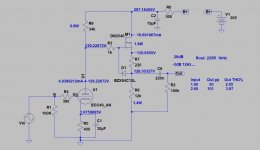Can I pick your collective brains for source follower designs for a simple tube preamp/driver stage?
I already know of Ale Moglia's source follower, which is one I will look at, but I would like to collect a variety of designs which offer a lower output impedance. I've seen simple designs with LND150 or other devices for instance.
The specimen tube stage is an ECC40, mu of around 30, with a B+ of 300v. Could be any similar triode. The goal would be a design that sounds as transparent as possible.
Any schematics or observations would be most welcome!

I already know of Ale Moglia's source follower, which is one I will look at, but I would like to collect a variety of designs which offer a lower output impedance. I've seen simple designs with LND150 or other devices for instance.
The specimen tube stage is an ECC40, mu of around 30, with a B+ of 300v. Could be any similar triode. The goal would be a design that sounds as transparent as possible.
Any schematics or observations would be most welcome!
Simply look at the basic tube books. If that were (objectively*) possible to do, it would be mentioned there.😉The goal would be a design that sounds as transparent as possible.
(*...in a way that is not influenced by personal feelings or opinions)
If i might advice to check preamps schematics at Vaccumstate site. Fvp (5) and Rtp (5) last stage could be of interest. Or full tube with the latest designs.
Hi Andy,
Why not try Ale's gyrator as anode load?
It's output impedance rivals tube CF.
Why not try Ale's gyrator as anode load?
It's output impedance rivals tube CF.
If you want simple, you could do one with FETs, like LND150 or similar. See the input FET follower on the LuminAria schematic. It could directly use the HV supply.
Fig 8:
https://audioxpress.com/assets/upload/files/AXApri2014_LuminAria SIT Preamp.pdf
Fig 8:
https://audioxpress.com/assets/upload/files/AXApri2014_LuminAria SIT Preamp.pdf
As you say, Bela, Ale's gyrator is another good way of doing it. It's on my "to do" list and I have a couple. I'm just exploring possibilities at the moment. The basic design appears to look like this. I don't know the values for R1 and R2, and it could also use a LND150 or something else maybe?

Andy,
I've used a version of Gary Pimm's solid state pentode.
Very low and very constant capacitances.
Both Gary and Allen Wright (RIP) though that important in preventing a "SS sound"
The usual precautions for source/cathode followers to prevent instability is required
t

I've used a version of Gary Pimm's solid state pentode.
Very low and very constant capacitances.
Both Gary and Allen Wright (RIP) though that important in preventing a "SS sound"
The usual precautions for source/cathode followers to prevent instability is required
t
I don't understand why one would need (or want) to use a depletion-mode FET for a DC-coupled source follower. An enhancement-mode FET would settle with something like (positive) 4 to 6 volts from source to gate. So if the plate voltage of the ECC40 was 130V, the source voltage of the source follower FET would be 124V to 126V, and it would be stable. R1 would not be necessary, unless you're using it as a build-out resistor (which could be put in series with the 1uF output cap instead). Choose a MOSFET with as low Crss as possible. FQPF2N50 or similar would be a reasonable choice. (IRF830 is an older generation MOSFET that has much higher Crss.)
I remember a thread in which SY mentioned DN2540 failed on him when he tried to use it as a source follower, so he went with an enhancement-mode MOSFET instead (but I don't remember which one).
I remember a thread in which SY mentioned DN2540 failed on him when he tried to use it as a source follower, so he went with an enhancement-mode MOSFET instead (but I don't remember which one).
How does ancient relate here to linearity?BTW these ancient tubes are not enough linear at large swing.
I can't remember if he has what you are after, but Lab JC https://www.labjc.com/ is worth a look for weird and wonderful hybrid circuits.
- Home
- Amplifiers
- Tubes / Valves
- Source follower designs for a tube preamp?
